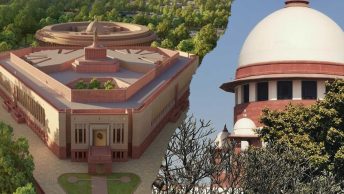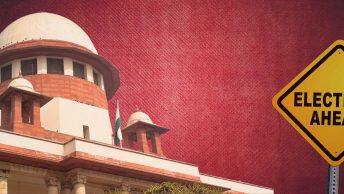(This is the second part of the post, where the authors make an argument regarding using the Unconstitutional State of Affairs doctrine to evaluate the legality and possible challenges to the demolition exercises that have been carried out in various Indian states. Part I of the blog can be accessed here.)
Oppressive State Actions and the Silent Judiciary: An Unconstitutional State of Affairs
The problem with the current set of incidents is the fact that while they prima facie look to be blatant acts of injustice, they are still carried out within the circumscribing boundaries of law. For example, the Jahangirpuri demolitions have been carried out under the provisions of the Delhi Municipal Corporation Act 1957 which enables such demolitions. Same is the case with Madhya Pradesh which carried out such demolitions under Madhya Pradesh Municipal Corporation Act, 1956 and Uttar Pradesh which did the same under its state act. However, the question that looms large is – Why is the judiciary silent while the rule of law is being bulldozed? Well, the answer is simple – All the acts are limited to being individual state acts and the constitutional jurisprudence, respecting the separation of powers, does not allow judicial scrutiny of these actions to go beyond assessment of their legal and constitutional validity.
So, does this mean that there exists no recourse to solve the conundrum? We will have to transgress the Indian borders to find viable solutions. One such could be found in the doctrine of – The unconstitutional state of affairs. Originally used by the Columbia Constitutional Court, the unconstitutional state of affairs doctrine empowers the Constitutional Court to acknowledge collusion or failure on part of both, the Legislative and the Executive, enabling the courts to enforce public policies to put an end to widespread and systemic violation of fundamental rights. While the courts refrain from intervening in policy matters, the justification for such intervention is found in the greater good of – restoring the constitutional state of affairs. Thus, by incorporating this doctrine in Indian Constitutional Jurisprudence, the judiciary can intervene in these matters.
India and the Doctrine of Unconstitutional State of Affairs
It is noteworthy that the Columbian Constitutional Court’s adoption of the doctrine of unconstitutional state of affairs was with an aim to make the state abide by its positive obligations towards the economic and social welfare of the people. This aim is evident from the cases where this doctrine was invoked, for example, cases dealing with the rights to pension, healthcare, education, etc. Hence, the doctrine was a tool that could be used by the Columbian Courts to command the state to fulfil its positive obligations towards its people.
In the present case of demolitions, the core problem is not the demolition of the allegedly illegal buildings, but rather the process being implemented to do the same. The violation of the procedural safeguard of serving notice is in itself an indicator of the patent illegality of such actions. Further, the victims are subjected to social and economic hardships as a result of financial loss due to demolition of property and social stigma arising directly out of such a move. These losses are a clear violation of state’s positive obligation towards its citizens. Such tainted procedures, deprived rights and ongoing violation of justice would be enough to fulfil the conditions under the doctrine of real effect.
The major challenge to enforcing this doctrine could be the ‘negative obligations’ connotation applied to Fundamental Rights under Part III of the Constitution of India. However, while the earlier jurisprudence indeed suggested that fundamental rights were negative obligations, the same was challenged by scholars from time to time. Further, there seems to be a shift in the jurisprudence as witnessed in Indibility Creative Pvt. Ltd. v Government of West Bengal where while writing for the Court, Chandrachud J., in the context of freedoms under Article 19 stated that apart from imposing ‘negative’ restraints on the state these freedoms impose a positive mandate on the state as well. The state is duty bound to ensure the prevalence of conditions in which of those freedoms can be exercised. Thus, merely discarding this doctrine on grounds of incongruence with the nature of obligations also stands refuted.
Another foreseeable major problem is how the Supreme Court would manage to monitor each and every case, especially in a category of events such as illegal construction, which is fairly routine and regular.The answer to it lies in the fact that it is not always the actions taken by the court which create a difference, sometimes mere belief that a supervisory approach is being undertaken is enough. While it may be too farfetched to say that the Supreme Court merely intervening would put an end to this menace, at the same time, it cannot be denied too that such an intervention could very well significantly lower the numbers.
Thus, the doctrine is not only the need of the hour but also completely justified in the current state of affairs. The Delhi CNG Bus Case, Taj Trapezium Case, etc. have clearly shown how mere intervention by the Supreme Court provided enough stimulus to the entire process which otherwise would have taken years to realize. It is this idea and understanding of the legal position which necessitates the implementation of the doctrine of unconstitutional state of affairs.
The Way Forward: Identification, Injunction and Adjudication
The unconstitutional state of affairs doctrine can be implemented by first identifying the exact ‘state of affairs’ which has become ‘unconstitutional’. This would then allow the judiciary to transition from its original position of a passive player to a political coordinator. Following the identification, a continuing mandamus can be released (similar to a structural injunction in the USA), which shall allow the judiciary to continually monitor the state of affairs and take appropriate actions. The entire concept of a structural injunction is that the courts release a series of interim orders over a period of time in an effort to stimulate institutional reform.
The concept of “structural injunctions” can be summed up in the following words of Owen Fiss “the formal medium through which the judiciary seeks to reorganize ongoing bureaucratic organizations so as to bring them into conformity with the Constitution”. While structural injunctions were a common phenomenon in the US Supreme Court, for example in the case of Brown v. Board of Education, there was no Indian variant for the same. Hence, the Supreme Court of India introduced a concept called “writ of continuing mandamus” – a modification of the writ of mandamus, under which public bodies or officials are ordered to perform a legal duty. Thus, from merely monitoring the implementation of its directions in the Bandhua Mukti Morcha case, the Supreme Court of India Court continued to blur the distinction between supervision and micro-management. This shift is evident from the Vineet Narain & Others v. Union of India case where the Court passed interim orders making far-reaching structural reforms, including insulating the director of the CBI from political interference. In a way, we can say that structural injunction is a standard feature of the remedial toolkit, and is invoked without any special justification by the Apex Court.
Following the same trend, the Court could mandate that any demolition ordered shall fall under the ambit of judicial scrutiny with the condition that execution of the same shall be subject to the outcome of such judicial scrutiny. This would benefit the entire process in two ways: a) prevent any further demolitions and b) allow for structural reforms in the due course of time. While the present approach may be criticized on the grounds of being ‘judicial overreach’, at a point of time when the two pillars of democracy have collapsed, the burden rests on the third pillar to support and reinstate the stability.






Thanks for sharing. I read many of your blog posts, cool, your blog is very good.